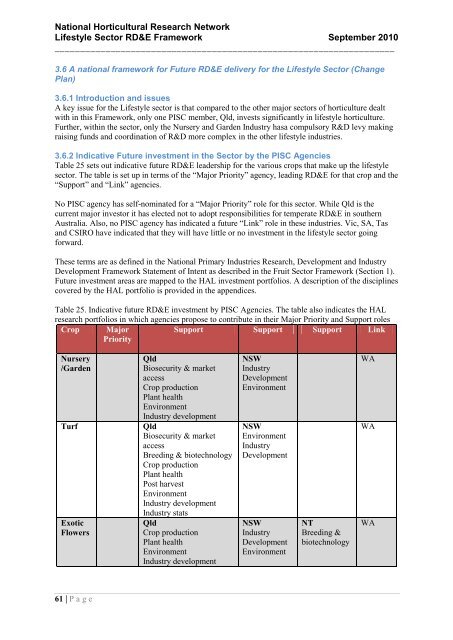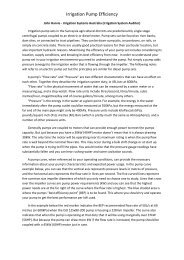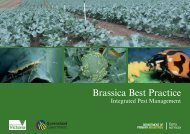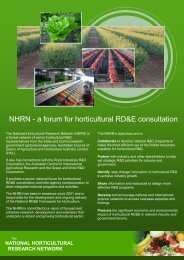National Horticultural Research Network - Horticulture Industry ...
National Horticultural Research Network - Horticulture Industry ...
National Horticultural Research Network - Horticulture Industry ...
Create successful ePaper yourself
Turn your PDF publications into a flip-book with our unique Google optimized e-Paper software.
<strong>National</strong> <strong>Horticultural</strong> <strong>Research</strong> <strong>Network</strong><br />
Lifestyle Sector RD&E Framework September 2010<br />
___________________________________________________________________<br />
3.6 A national framework for Future RD&E delivery for the Lifestyle Sector (Change<br />
Plan)<br />
3.6.1 Introduction and issues<br />
A key issue for the Lifestyle sector is that compared to the other major sectors of horticulture dealt<br />
with in this Framework, only one PISC member, Qld, invests significantly in lifestyle horticulture.<br />
Further, within the sector, only the Nursery and Garden <strong>Industry</strong> hasa compulsory R&D levy making<br />
raising funds and coordination of R&D more complex in the other lifestyle industries.<br />
3.6.2 Indicative Future investment in the Sector by the PISC Agencies<br />
Table 25 sets out indicative future RD&E leadership for the various crops that make up the lifestyle<br />
sector. The table is set up in terms of the “Major Priority” agency, leading RD&E for that crop and the<br />
“Support” and “Link” agencies.<br />
No PISC agency has self-nominated for a “Major Priority” role for this sector. While Qld is the<br />
current major investor it has elected not to adopt responsibilities for temperate RD&E in southern<br />
Australia. Also, no PISC agency has indicated a future “Link” role in these industries. Vic, SA, Tas<br />
and CSIRO have indicated that they will have little or no investment in the lifestyle sector going<br />
forward.<br />
These terms are as defined in the <strong>National</strong> Primary Industries <strong>Research</strong>, Development and <strong>Industry</strong><br />
Development Framework Statement of Intent as described in the Fruit Sector Framework (Section 1).<br />
Future investment areas are mapped to the HAL investment portfolios. A description of the disciplines<br />
covered by the HAL portfolio is provided in the appendices.<br />
Table 25. Indicative future RD&E investment by PISC Agencies. The table also indicates the HAL<br />
research portfolios in which agencies propose to contribute in their Major Priority and Support roles<br />
Crop Major<br />
Priority<br />
Support Support Support Link<br />
Nursery<br />
/Garden<br />
Turf<br />
Exotic<br />
Flowers<br />
Qld<br />
Biosecurity & market<br />
access<br />
Crop production<br />
Plant health<br />
Environment<br />
<strong>Industry</strong> development<br />
Qld<br />
Biosecurity & market<br />
access<br />
Breeding & biotechnology<br />
Crop production<br />
Plant health<br />
Post harvest<br />
Environment<br />
<strong>Industry</strong> development<br />
<strong>Industry</strong> stats<br />
Qld<br />
Crop production<br />
Plant health<br />
Environment<br />
<strong>Industry</strong> development<br />
NSW<br />
<strong>Industry</strong><br />
Development<br />
Environment<br />
NSW<br />
Environment<br />
<strong>Industry</strong><br />
Development<br />
NSW<br />
<strong>Industry</strong><br />
Development<br />
Environment<br />
NT<br />
Breeding &<br />
biotechnology<br />
WA<br />
WA<br />
WA<br />
61 | P a g e






